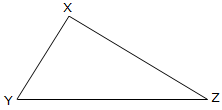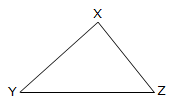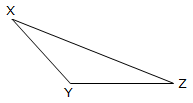Equilateral triangle: An equilateral triangle is a triangle whose all three sides are equal.
<a href="https://www.math-only-math.com/images/Equilateral-triangle.png" rel="gallery[pageGallery]" title="Equilateral Triangle"> </a>
</a>
Here, XYZ is an equilateral triangle as XY = YZ = ZX.
Isosceles triangle: An isosceles triangle is a triangle whose any two sides are equal.
<a href="https://www.math-only-math.com/images/Isosceles-triangle.png" rel="gallery[pageGallery]" title="Isosceles Triangle"> </a>
</a>
The adjoining figure shows an isosceles triangle where XY = XZ.
Scalene triangle: In a scalene triangle, all the three sides are unequal.
<a href="https://www.math-only-math.com/images/Scalene-triangle.png" rel="gallery[pageGallery]" title="Scalene Triangle"> </a>
</a>
The above figure shows a scalene triangle where XY ≠ YZ ≠ ZX.
Acute-angled triangle: If all the three angles of a triangle are acute angles (i.e., each measures less than 90°), it is called an acute-angled triangle.
<a href="https://www.math-only-math.com/images/Acute-angled-triangle.png" rel="gallery[pageGallery]" title="Acute-angled Triangle"> </a>
</a>
Here, ∠XYZ, ∠YZX and ∠ZXY are all acute angles.
Right-angled triangle: If one of the angles of a triangle is a right angle (i.e., measures 90°), it is called a right-angled triangle.
<a href="https://www.math-only-math.com/images/Right-angled-triangle.png" rel="gallery[pageGallery]" title="Right-angled Triangle"> </a>
</a>
Here, <XYZ = 90°.
Therefore, ∆ XYZ is a right-angled triangle.
Obtuse-angled triangle: If any of the three angles of a triangle is an obtuse angles (i.e., measures more than 90°), it is called an obtuse-angled triangle.
<a href="https://www.math-only-math.com/images/Obtuse-angled-triangle.png" rel="gallery[pageGallery]" title="Obtuse-angled Triangle"> </a>
</a>
Here, ∠XYZ > 90°.
Therefore, ∆ XYZ is an obtuse-angled triangle.




 myCBSEguide
myCBSEguide

Yogita Ingle 4 years, 11 months ago
Equilateral triangle: An equilateral triangle is a triangle whose all three sides are equal.
<a href="https://www.math-only-math.com/images/Equilateral-triangle.png" rel="gallery[pageGallery]" title="Equilateral Triangle"> </a>
</a>
Here, XYZ is an equilateral triangle as XY = YZ = ZX.
Isosceles triangle: An isosceles triangle is a triangle whose any two sides are equal.
<a href="https://www.math-only-math.com/images/Isosceles-triangle.png" rel="gallery[pageGallery]" title="Isosceles Triangle"> </a>
</a>
The adjoining figure shows an isosceles triangle where XY = XZ.
Scalene triangle: In a scalene triangle, all the three sides are unequal.
<a href="https://www.math-only-math.com/images/Scalene-triangle.png" rel="gallery[pageGallery]" title="Scalene Triangle"> </a>
</a>
The above figure shows a scalene triangle where XY ≠ YZ ≠ ZX.
Acute-angled triangle: If all the three angles of a triangle are acute angles (i.e., each measures less than 90°), it is called an acute-angled triangle.
<a href="https://www.math-only-math.com/images/Acute-angled-triangle.png" rel="gallery[pageGallery]" title="Acute-angled Triangle"> </a>
</a>
Here, ∠XYZ, ∠YZX and ∠ZXY are all acute angles.
Right-angled triangle: If one of the angles of a triangle is a right angle (i.e., measures 90°), it is called a right-angled triangle.
<a href="https://www.math-only-math.com/images/Right-angled-triangle.png" rel="gallery[pageGallery]" title="Right-angled Triangle"> </a>
</a>
Here, <XYZ = 90°.
Therefore, ∆ XYZ is a right-angled triangle.
Obtuse-angled triangle: If any of the three angles of a triangle is an obtuse angles (i.e., measures more than 90°), it is called an obtuse-angled triangle.
<a href="https://www.math-only-math.com/images/Obtuse-angled-triangle.png" rel="gallery[pageGallery]" title="Obtuse-angled Triangle"> </a>
</a>
Here, ∠XYZ > 90°.
Therefore, ∆ XYZ is an obtuse-angled triangle.
0Thank You